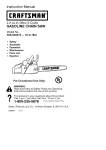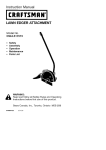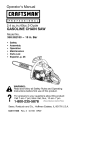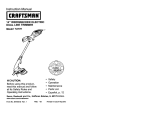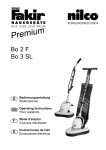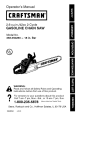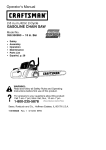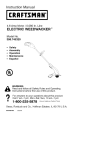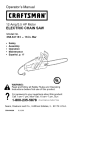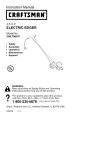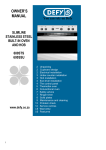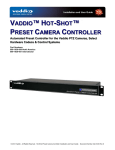Download Craftsman 358.341080 Operator`s manual
Transcript
Operator's
Manual
I CRAFTSMAN°I
12 Amp/3.75
HP Motor
ELECTRIC
CHAIN
Model No.
358.341080
SAW
- 16 in. Bar
•
Safety
•
Assembly
•
•
Operation
Maintenance
•
Espar_ol,
p. 17
WARNING:
@
Read and follow all Safety Rules and Operating
Instructions
before first use of this product.
For
Call answers
7 am-7
•
1-800-235-5878
Sears, Roebuck
530165786
to your
questions
about pm,
this product:
pm,
Mon-Sat;
10 am-7
Sun
(Hours
and Co., Hoffman
9/12/06
listed are CentraITime)
Estates,
IL 60179
U.S.A.
Warranty
Safety Rules
Assembly
Operation
Maintenance
ONE YEAR FULL WARRANTY
2
2
7
7
12
Service and Adjustments
Storage
Troubleshooting
Table
Spanish
Parts Ordering
ON CRAFTSMAN
ELECTRIC
14
15
16
17
Back Cover
CHAIN
SAW.
When used and maintained according to the operator's manual, if this product fails
due to a defect in material or workmanship within one year from the date of purchase, return it to any Sears store or other Craftsman outlet in the United States for
free replacement.
This warranty excludes the bar and chain, which are expendable parts that can
wear out from normal use in less than one year.
This warranty applies for only 30 days from purchase date if this product is used
for commercial or rental purposes.
This warranty gives you specific legal rights, and you may also have other rights
which vary from state to state.
Sears, Roebuck and Co., Hoffman Estates, IL 60179
,t%
dt_WARNING:
When using electric
gardening appliances, basic safety
precautions must always be followed
to reduce the risk of fire, electric shock,
and serious injury. Read and follow all
instructions.
WARNING:
Always disconnect
unit from power source when making
repairs, adjustments, and when changing accessories and attachments such
as saw bar, chain or guards.
Because a chain saw is a high-speed
woodcutting tool, special precautions
must be observed to reduce risk of accidents. Careless or improper use of this
tool can cause serious injury.
PLAN AHEAD
• Restrict the use of your saw to adult
users who understand and can follow the safety rules, precautions,
and operating instructions found in
this manual.
• Dress properly. Wear protective gear.
Always use steel-toed safety footwear with non-slip soles; snug-fitting
clothing; heavy-duty, non-slip gloves;
eye protection such as non-fogging,
vented goggles or face screen; an
approved safety hard hat; and sound
barriers (ear plugs or mufflers) to protect your hearing. Regular users
should have hearing checked regularly as chain saw noise can damage
hearing.
• Secure hair above shoulder length.
Do not wear loose clothing or jewelry; they can get caught in moving
parts.
Headng
Protection __"
_
I _D'IIIp
._- ....
Snug
Fitting
Clothing
Safety Hat
Eye
Protection
Heavy Duty
Gloves
Safety
Shoes "_
,_
Safety Chaps
a41i
• Keep all parts of your body away
from the chain when saw is running.
• Keep children away. Do not let visitors
contact chain saw or extension cord.
All visitors should be kept at least 30
feet (10 meters) away from work area.
• Do not handle or operate a chain saw
when you are fatigued, ill, upset, or if
you have taken alcohol, drugs, or medication. You must be in good physical
condition and mentally alert. If you
have any condition that might be aggravated by strenuous work, check
with doctor before operating. Watch
whatyouaredoing.
Usecommon
sense.
• Donotstartcutting
untilyouhavea
clear
workarea,
secure
footing,
and
especially
ifyouarefelling
atree,a
retreat
path.Keep
workareaclean.
OPERATE
YOUR
SAW SAFELY
• Do not operate with one hand. Serious injury to the operator, helpers, or
bystanders may result from onehanded operation. A chain saw is intended for two-handed use.
• Do not operate saw from a ladder or
in a tree.
• Make sure the chain will not make
contact with any object while starting
the saw. Never start the saw when
the guide bar is in a cut.
• Do not force chain saw. It will do the
job better and safer at the rate for
which it was intended.
• Do not put pressure on the saw, especially at the end of the cut. Doing
so can cause you to lose control
when the cut is completed.
• Stop the saw before setting it down.
• Hand carry saw only when motor is
stopped. Carry the chain saw by the
front handle with the saw stopped, finger off the switch, the guide bar and
saw chain to the rear.
• Use the right tool, cut wood only.
Don't use chain saw for purpose not
intended; for example, don't use
chain saw for cutting plastic, masonry, non-wood building materials.
• Do not operate a chain saw that is
damaged, improperly adjusted, or
not completely and securely assembled. Always replace bar, chain,
hand guard, or other parts immediately if they become damaged, broken, or are otherwise removed.
• Inspect chain saw cords periodically
and if damaged, have repaired by a
Sears Service Center.
MAINTAIN
YOUR
SAW IN GOOD
WORKING ORDER
• Have all chain saw service performed by a Sears Service Center
except the items listed in the MAINTENANCE section of this manual.
• Make certain saw chain stops moving when trigger switch is released.
• Keep the handles dry and clean and
free from oil and grease.
• Keep oil cap and fasteners securely
tightened.
• Nonconforming replacement components or the removal of safety devices
may cause damage to the unit and
possible injury to the operator or bystanders. Use only Craftsman accessories and replacement parts as recommended.
Never modify your saw.
• Maintain chain saw with care.
• Keep unit sharp and clean for better
and safer performance.
• Follow instructions for lubricating and
changing accessories.
• Unplug the chain saw from the power
source when not in use, before servicing, and when changing accessories
and attachments, such as saw chain
and guard.
• Check for damaged parts. Before further use of the chain saw, a guard or
other part that is damaged should be
carefully checked to determine that it
will operate properly and perform its
intended function. Check for alignment
of moving parts, binding of moving
parts, breakage of parts, mounting and
any other conditions that may affect its
operation. A guard or other part that is
damaged should be properly repaired
or replaced by a Sears Service Center
unless otherwise indicated elsewhere
in the operator's manual.
• When not in use, chain saws should
be stored in a dry, high or locked-up
place out of the reach of children.
• When storing saw, unplug and use a
bar sheath or carrying case.
ELECTRICAL
SAFETY
_I, WARNING:
Avoid a dangerous
environment.
To reduce the risk of
electrical shock, do not use in rain, in
damp or wet locations, or around
swimming pools, hot tubs, etc. Do not
expose to snow, rain, or water to avoid
the possibility of electrical shock. Do
not handle extension cord or plug with
wet hands.
• Use only a voltage supply as shown
on the nameplate of the unit.
• Avoid dangerous situations. Do not
use in the presence of flammable liquids or gases to avoid creating a fire
or explosion and/or causing damage
to unit.
• To reduce the risk of electrical shock,
this appliance has a polarized plug
(one blade is wider than the other) and
will require the use of a polarized ex-
oroutlet
tobeused.
Retension
cord.
Theappliance
plugwillfit oncircuit
intoapolarized
extension
cord
only
ceptacles
areavailable
having
builtoneway.
Iftheplugdoes
notfitfully
inGFCI
protection
andmaybeused
intotheextension
cord,
reverse
the
forthismeasure
ofsafety.
Inspect
plug.
Iftheplugstilldoes
notfit,obtain chainsawcords
periodically
andif
acorrect
polarized
extension
cord.
A
damaged,
haverepaired
bya Sears
Service
Center.
polarized
extension
cord
willrequire
theuseofapolarized
walloutlet.
This GUARD AGAINST KICKBACK
plugwillfitintothepolarized
walloutlet
all safety rules to help avoid kickonlyoneway.
Ifplugdoes
notfitfully Follow
and other forces which can result
intothewalloutlet,
reverse
theplug.
If back
in serious injury.
theplugstilldoes
notfit,contact
a
qualified
electrician
toinstall
theproper
,"_' _'2"--,__-,
_'
Kickback Path
walloutlet.
Donotchange
theequipment
plug,
extension
cordreceptacle,
orextension
cordpluginanyway.
• Toreduce
riskofelectrical
shock,
use
extension
cords
specifically
marked
as
suitable
foroutdoor
appliances.
The
electrical
rating
ofthecordmust
notbe
Avoid Obstructions
lessthantherating
oftheunit.The
cordmust
bemarked
withsuffix
"W-A"
(inCanada,
'MT").
Useapolarized
cord.Make
sureyourextension
cord
isingood
condition.
Inspect
extension
cordbefore
useandreplace
ifdamClear The Working Area
aged.
Donotuseadamaged
cord.
Cord
insulation
must
beintact
withno A
WARNING:
Avoid kickback which
cracks
ordeterioration.
Plug
connectorsmust
beundamaged.
Anunder- can result in serious injury. Kickback
sized
extension
cordwillcause
adrop is the backward, upward or sudden forinlinevoltage
resulting
inlossofpow- ward motion of the guide bar occurring
erandoverheating.
Ifindoubt,
usethe when the saw chain near the upper tip
nextheavier
gauge.
Thelower
the
of the guide bar contacts any object
gauge
number,
theheavier
thecord such as a log or branch, or when the
(seeSELECT
ANEXTENSION
CORD
in wood closes in and pinches the saw
theOPERATION
section).
Donotuse chain in the cut. Contacting a foreign
multiple
cords.
object in the wood can also result in
• Donotabuse
cord.Never
carrythe loss of chain saw control.
• Rotational Kickback can occur
unitbytheextension
cordoryank
extension
cordtodisconnect
unit.
when the moving chain contacts an
• Secure
extension
cordtopower
cord object at the upper tip of the guide
bar. This contact can cause the
toprevent
disconnection
fromunit.
• Donotusetheunitiftheswitch
does chain to dig into the object, which
notturntheunitonandoffproperly, stops the chain for an instant. The
orifthelock-out
doesnotwork.Reresult is a lightning fast, reverse
pairs
totheswitch
must
bemade
by
reaction which kicks the guide bar up
aSears
Service
Center.
and back toward the operator.
• Keep
extension
cordclear
ofopera- • Pinch-Kickback can occur when the
torandobstacles
atalltimes.
Posithe wood closes in and pinches the
tioncordsothatitwillnotbecaught moving saw chain in the cut along
onbranches.
Donotexpose
cords
to the top of the guide bar and the saw
heat,oil,water,
orsharp
edges.
chain is suddenly stopped. This sud• Toavoid
thepossibility
ofelectric
den stopping of the chain results in a
reversal of the chain force used to
shock,
avoid
bodycontact
withany
grounded
conductor,
suchasmetal cut wood and causes the saw to
fences
orpipes.
move in the opposite direction of the
chain rotation. The saw is driven
• Ground
FaultCircuit
Interrupter
(GFCI)
protection
should
beprovided straight back toward the operator.
• Pull-In
canoccur
when
themoving
chain
contacts
aforeign
object
inthe
woodinthecutalong
thebottom
of
theguide
barandthesawchainis
suddenly
stopped.
Thissudden
stoppingpullsthesawforward
andaway
fromtheoperator
andcouldeasily
cause
theoperator
tolosecontrol
of
thesaw.
REDUCE THE CHANCE OF
KICKBACK
• Recognize that kickback can happen.
With a basic understanding of kickback, you can reduce the element of
surprise which contributes to accidents.
• Never let the moving chain contact
any object at the tip of the guide bar.
• Keep working area free from obstructions such as other trees, branches,
rocks, fences, stumps, etc. Eliminate
or avoid any obstruction that your
saw chain could hit while cutting.
• When cutting a branch, do not let the
guide bar contact another branch or
other objects around it.
• Keep saw chain sharp and properly
tensioned. A loose or dull chain can
increase the chance of kickback.
Follow manufacturer's
chain sharpening and maintenance instructions.
Check tension at regular intervals,
but never with engine running. Make
sure bar clamp nuts are securely
tightened.
• Begin and continue cutting at full
speed. If the chain is moving at a
slower speed, there is greater
chance of kickback occurring.
• Use extreme caution when re-entering a cut.
• Do not attempt cuts starting with the
tip of the bar (plunge cuts).
• Watch for shifting logs or other objects that could close a cut and pinch
or fall onto chain.
• Use the specified Reduced-Kickback
Guide Bar and Low Kickback Chain.
Avoid Pinch-Kickback:
• Be extremely aware of situations or
obstructions that can cause material
to pinch the top of or otherwise stop
the chain.
• Do not cut more than one log at a
time.
• Do not twist the saw as the bar is
withdrawn from an undercut when
bucking.
Avoid Pull-In:
• Always begin cutting with the saw at
full speed and the saw housing
against wood.
• Use wedges made of plastic or
wood. Never use metal to hold the
cut open.
MAINTAIN CONTROL:
Stand to the left of the sa_
Thumb on
Y'",,_ _;_p
underside
[ _ "_
of handlebar
kt:_ _,
Never reverse
hand positions
-_. __e
"_/_
Elbow
locked
• A good, firm grip on the saw with
both hands will help you maintain
control. Don't let go. Grip the rear
handle with your right hand whether
you are right or left handed. Wrap the
fingers of your left hand over and
around the front handlebar, and your
left thumb under the front handlebar.
Keep your left arm straight with the
elbow locked.
• Position your left hand on the front
handlebar so it is in a straight line
with your right hand on the rear handle when making bucking cuts.
Stand slightly to the left side of the
saw to keep your body from being in
a direct line with the cutting chain.
• Stand with your weight evenly balanced on both feet.
• Do not overreach. You could be drawn
or thrown off balance and lose control.
• Do not cut above shoulder height. It
is difficult to maintain control of saw
above shoulder
height.
KICKBACK
SAFETY
FEATURES
_WARNING:
The following features are included on your saw to help
reduce hazard of kickback; however,
such features will not totally eliminate
this danger. Do not rely only on safety
devices. Follow all safety rules to help
avoid kickback and other forces which
can result in serious injury.
• Hand Guard: designed to reduce the
chance of your left hand contacting
the chain if your hand slips off the
front handlebar.
• Position of front and rear handlebars:
designed with distance between
handles and "in-line" with each other.
The spread and "in-line" position of
the hands provided by this design
work together to give balance and
resistance in controlling the pivot of
the saw back toward the operator if
kickback occurs.
• Reduced-Kickback
Guide Bar: designed with a small radius tip which
reduces the size of the kickback
danger zone on the bar tip. This type
bar has been demonstrated to significantly reduce the number and seriousness of kickbacks when tested in
accordance with ANSI B175.1.
_"_.&
TSip_uiRaJi_Sr
)
• Low Kickback Chain has met kickback performance
requirements
when tested on the representative
sample of these chain saws specified in ANSI B175.1.
Low Kickback Chain
Contoured Depth Gauge
l::_-,_-_-_
_
--\_
_
_,-_
Elongated Guard Link
Deflects Kickback Force
And Allows Wood To
Gradually Ride Into Cutter
SAFETY NOTICE: Exposure to vibrations through prolonged use of hand
tools could cause blood vessel or
nerve damage in the fingers, hands,
and joints of people prone to circulation disorders or abnormal swelling.
Prolonged use in cold weather has
been linked to blood vessel damage in
otherwise healthy people. If symptoms
occur such as numbness, pain, loss of
strength, change in skin color or texture, or loss of feeling in the fingers,
hands, or joints, discontinue the use of
this tool and seek medical attention.
An anti-vibration system does not
guarantee the avoidance of these
problems. Users who operate power
tools on a continual and regular basis
must closely monitor their physical
condition and the condition of this tool.
DOUBLE INSULATION
CONSTRUCTION
This unit is double insulated to help protect against electric shock. Double insulation construction consists of two
separate "layers" of electrical insulation
instead of grounding.
Tools and appliances built with this insulation system are not intended to be
grounded. No grounding means is provided on this unit, nor should a means
of grounding be added to this unit. As a
result, the extension cord used with this
unit can be plugged into any polarized
120 volt electrical outlet.
Safety precautions must be observed
when operating any electrical tool. The
double insulation system only provides
added protection against injury resulting
from an internal electrical insulation
failure.
_1_ WARNING:
All electrical
repairs
to this unit, including housing, switch,
motor, etc., must be diagnosed and repaired by qualified service personnel.
Replacement parts for a double insulated appliance must be identical to the
parts they replace. A double insulated
appliance is marked with the words
"double insulation" or "double insulated". The symbol [] (square within a
square) may also be marked on the
appliance. Failure to have the unit repaired by Sears service personnel can
cause the double insulation construction to become ineffective and result in
serious injury.
STANDARDS: This product is listed by
Underwriters Laboratories, Inc. in accordance with UL Standard 1662 and
ANSI B175.1.
ANSI B175.1-2000
"American National Standard for Powered Tools - Safety Requirements".
SAVE THESE
INSTRUCTIONS
CARTON CONTENTS
Check carton contents against the following list,
Model 358.341080
NOTE: If you need assistance or find
that parts are missing or damaged,
please call 1-800-235-5878
ASSEMBLY
• Chain Saw (fully assembled)
• Bar Sheath
Examine parts for damage. Do not use
damaged parts.
Your unit is fully assembled;
bly is required.
KNOW YOUR CHAIN
no assem-
SAW
READ THIS OPERATOR'S MANUAL AND SAFETY RULES BEFORE OPERATING YOUR
CHAIN SAW. Compare the illustrations with your unit to familiarize yourself with the
location of the various controls and adjustments. Save this manual for future reference.
Bar Oil Cap
!_._.._J/'-."."."."."._"
_IIll
Trigger
Loe k - o u_._..,j...,_.f_.,_5_
Hand Guard
Chain Adjustment
/
Screw
Button_
Powe
ocket
Cord
TRIGGER
" _
Trigger
Switch
Oil Levet
Indicator
SWITCH
The TRIGGER SWITCH is used to turn
on the unit. Squeeze the trigger switch
to operate the unit after lock-out button has been pushed forward. Release
the trigger to turn the unit off.
TRIGGER
LOCK-OUT
BUTTON
The TRIGGER LOCK-OUT button is a
control feature designed to prevent the
motor from being accidentally started.
When the rear handle is gripped in a
normal cutting position, the trigger
lock-out button can be pushed forward
by the thumb, permitting the index finger to squeeze the trigger. It is not necessary to maintain pressure on the
trigger lock-out button once the trigger
has been engaged.
OPERATING
Bar Clamp _'
Hole
BAR OIL CAP
The BAR OIL CAP is used to fill the bar
oil tank.
CHAIN ADJUSTMENT
SCREW
The CHAIN ADJUSTMENT SCREW is
used to adjust the chain tension.
POWER CORD
The POWER CORD is used to connect
the chain saw to an approved extension cord.
CHAIN TENSION
It is normal for a new chain to stretch
during first 30 minutes of operation.
You should check your chain tension
frequently. Readjust chain after every
15 minutes of operation. See CHECK
CHAIN TENSION under the SERVICE
AND ADJUSTMENTS section.
INSTRUCTIONS
MINIMUM WIRE GAUGE
RECOMMENDATIONS
Use only a voltage supply as specified
on your unit.
SELECT AN EXTENSION CORD
Extension cords are available for this
unit at Sears.
Chah_
Volts
120
• American
25ft.
(7.67 M)
16
A W.G.*
Wire
Gauge
50ft.
(15.24 M)
16
A.W.G*
100 ft.
(30.48 M)
14
A.W.G.*
ATTACH THE EXTENSION CORD TO
YOUR CHAIN SAW
To prevent disconnection from unit, secure extension cord to power cord as
shown in the following illustration.
Power Cord
Extension Cord
BEFORE
STARTING
_WARNING:
SAW
Be sure to read tile
electrical safety information in the safety rules section of this manual before
you begin. If you do not understand
the electrical safety information do not
attempt to use your unit. Seek help
from someone that does understand
the information or call the customer assistance help line at 1-800-285-5878.
GUIDE BAR AND CHAIN OIL
The bar and chain require lubrication.
The chain oiler provides lubrication to
the chain and guide bar. Be sure to fill
the bar oil tank before each cutting session. Lack of oil will quickly ruin the bar
and chain. Too little oil will cause overheating shown by smoke coming from
the chain and/or discoloration of the bar.
For maximum guide bar and chain life,
we recommend you use Craftsman
chain saw bar oil. If Craftsman bar oil is
not available, you may use a good
grade SAE 30 oil until you are able to
obtain Craftsman brand. Use a funnel to
fill the tank. Replace oil cap securely.
Check oil level after every 15 minutes of
operation. Oil level can be monitored by
viewing the oil level indicator (see illustration in KNOW YOUR CHAIN SAW
section).
STOPPING YOUR UNIT
Release the trigger switch.
• If motor does not stop, disconnect
the extension cord. Discontinue use
of unit until repaired by a Sears Service Center.
STARTING YOUR UNIT
1. Connect the saw to a power source
using the proper size extension cord
(see SELECT AN EXTENSION CORD
in the OPERATION section).
2. Grip both handles firmly.
3. Push and hold the trigger lock-out
button with your right hand thumb.
4. Squeeze and hold the trigger switch.
OPERATING TIPS
• Check chain tension before first use
and after 1 minute of operation. See
CHECK CHAIN TENSION in the SERVICE AND ADJUSTMENTS section.
• Cut wood only. Do not cut metal,
plastics, masonry, non-wood building
materials, etc.
• Stop the saw if the chain strikes a
foreign object. Inspect the saw and
repair parts as necessary.
• Keep the chain out of dirt and sand.
Even a small amount of dirt will
quickly dull a chain and increase the
possibility of kickback.
• Practice cutting a few small logs using
the following steps. This will help you
get the "feel" of using your saw before
you begin a major sawing operation.
• Squeeze trigger switch and allow
unit to reach full speed before cutting.
• Begin cutting with the saw frame
against the log.
• Keep the motor at full speed the
entire time you are cutting.
• Release the trigger switch as soon
as the cut is completed, allowing
the motor to stop.
• Keep the cord away from the cutting area. Position cord so it will not
be caught on branches and the like
during cutting.
• To avoid losing control when cut is
complete, do not put pressure on
saw at end of cut.
• Stop the saw before setting it down.
TREE FELLING
TECHNIQUES
tJ, ________
_I, WARNING:
Check for broken or
dead branches which can fall while
cutting causing serious injury. Do not
cut near buildings or electrical wires if
you do not know the direction of tree
fall, nor cut at night since you will not
be able to see well, nor during bad
weather such as rain, snow, or strong
winds, etc. If the tree does make contact with any utility line, the utility company should be notified immediately.
• Carefully plan your sawing operation in
advance.
• Clear the work area. You need a clear
area all around the tree so you can
have secure footing.
• The chain saw operator should keep
on the uphill side of the terrain as the
tree is likely to roll or slide downhill after it is felled.
• Study
thenatural
conditions
thatcan
cause
thetreetofallinaparticular
direction;
such
conditions
include:
• Thewinddirection
andspeed.
• Theleanofthetree.Theleanofa
treemight
notbeapparent
dueto
uneven
orsloping
terrain.
Usea
plumb
orlevel
todetermine
thedirection
oftreelean.
• Weight
andbranches
ononeside.
• Surrounding
treesandobstacles.
• Look
fordecay
androt.Ifthetrunkis
rotted,
itcansnap
andfalltoward
the
operator.
• Make
surethereisenough
room
for
thetreetofall.Maintain
adistance
of
2-1/2
treelengths
fromthenearest
person
orother
objects.
Noise
can
drown
outawarning
call.
• Remove
dirt,stones,
loose
bark,
nails,
staples,
andwirefromthetree
where
cutsaretobemade.
_,,'_e
-t....
FELLING
First cut
Notch
Second
cut
LARGE TREES
(6 inches in diameter or larger)
The notch method is used to fell large
trees. A notch is cut on the side of the
tree in tile desired direction of fall. After
a felling cut is made on the opposite
side of tree, the tree will tend to fall in
the direction of the notch.
NOTE: If tree has large buttress roots,
remove them before making the notch.
If using saw to remove buttress roots,
keep saw chain from contacting
ground to prevent dulling of the chain.
NOTCH CUT AND FELLING TREE
• Make notch cut by cutting the top of
the notch first. Cut through 1/3 of the
diameter of the tree. Next complete
the notch by cutting the bottom. See
illustration. Once the notch is cut remove the wedge
tree.
Opening
of felling
out
a
Direction of fall
of wood from the
Hinge
• After removing the wood from the
notch, make the felling cut on the opposite side of the notch. This is done
by making a cut about two inches
higher than the center of the notch.
This will leave enough uncut wood
between the felling cut and the notch
to form a hinge. This hinge will help
prevent the tree from falling in the
wrong direction.
Hinge holds tree on stump and helps
control fall
path
Planclear
retreat
('_.._,
Felling cut here
Closing of
notch
NOTE: Before felling cut is complete,
use wedges to open the cut if necessary to control the direction of fall. To
avoid kickback and chain damage, use
wood or plastic wedges, but never
steel or iron wedges.
• Be alert to signs that the tree is
ready to fall: cracking sounds, widening of the felling cut, or movement in
the upper branches.
• As tree starts to fall, stop saw, put it
down, and get away quickly on your
planned retreat path.
• DO NOT use your saw to cut down a
partially fallen tree. Be extremely cautious with partially fallen trees that may
be poorly supported. When a tree
doesn't fall completely, set saw aside
and pull down tree with a cable winch,
block and tackle, or tractor.
CUTTING A FALLEN TREE
(BUCKING)
Bucking is tile term used for cutting a
fallen tree to the desired log size.
_&WARNING:
Do not stand on the
log being cut. Any portion can roll
causing loss of footing and control. Do
not stand downhill of the log being cut.
IMPORTANT
POINTS
• Cutonlyonelogatatime.
• Cutshattered
wood
verycarefully;
sharp
pieces
ofwood
couldbeflung
toward
operator.
• Useasawhorse
tocutsmalllogs.
Never
allow
another
person
tohold
thelogwhile
cutting
andnever
hold
thelogwithyourlegorfoot.
• Donotcutinanarea
where
logs,
limbs,
androotsaretangled.
Drag
logsintoaclearareabefore
cutting
thembypulling
outexposed
and
cleared
logsfirst.
BUCKING
TECHNIQUES
sion side of the log is where the pressure of the log's weight is concentrated.
First cut on compression side of log
Second
cut
Second
First cut on compression side of log
BUCKING
WARNING:
If saw becomes
pinched or hung in a log, don't try to
force it out. You can lose control of the
saw resulting in injury and/or damage
to the saw. Stop the saw, drive a
wedge of plastic or wood into the cut
until the saw can be removed easily.
Restart the saw and carefully reenter
the cut. Do not use a metal wedge. Do
not attempt to restart your saw when it
is pinched or hung in a log.
WITHOUT
A SUPPORT
• Overcut through 1/3 of the diameter
of the log.
• Roll the log over and finish with a
second overcut.
• Watch for logs with a compression
side to prevent the saw from pinching. See illustration above for cutting
logs with a compression side.
BUCKING USING A LOG OR
SUPPORT STAND
• Remember your first cut is always on
the compression side of the log.
(Refer to the illustration below for
your first and second cut)
• Your first cut should extend 1/3 of the
diameter of the log.
• Finish with your second cut.
Using a log for support
Use a wedge to remove pinched saw.
Turn saw OFF and use a plastic or
wooden wedge to force cut open.
2 nd Cut
Overeutting
begins on the top side of
the log with the bottom of the saw
against the log. When overcutting use
light downward pressure.
Overcutting
cut
Undercutting
Undercutting involves cutting on the
underside of the log with top of saw
against the log. When undercutting use
light upward pressure. Hold saw firmly
and maintain control. The saw will tend
to push back toward you.
2 nd Cut
\'= :__
Using a support stand
WARNING:
Never turn saw upside down to undercut, The saw cannot be controlled in this position.
t
Always make your first cut on the compression side of the log. The compres10
2 nd
tp
Cut
Cut
1st Cut
L_
/
_
2 nd Cut
LIMBING AND PRUNING
WARNING;
Be alert for and
guard against kickback.
Do not allow
the moving chain to contact any other
branches or objects at the nose of the
guide bar when limbing or pruning. Allowing such contact can result in serious injury.
_WARNING:
Never climb into a
tree to limb or prune. Do not stand on
ladders, platforms, a log, or in any position which can cause you to lose
your balance or control of the saw.
IMPORTANT
POINTS
• Watch out for spring poles. Spring
poles are small size limbs which can
whip toward you or pull you off balance. Use extreme caution when
cutting small size limbs.
• Be alert for spring back from any
branches that are bent or under
pressure. Avoid being struck by the
branch or the saw when the tension
in the wood fibers is released.
• Frequently clear branches out of the
way to avoid tripping over them.
LIMBING
• Limb a tree only after it is cut down.
• Leave the larger limbs underneath
the felled tree to support the tree as
you work.
• Start at the base of the felled tree
and work toward the top, cutting
branches and limbs. Remove small
limbs with one cut.
• Keep the tree between you and the
chain.
• Remove larger branches with the
cutting techniques described in
BUCKING WITHOUT A SUPPORT.
• Always use an overcut to cut small
and freely hanging limbs. Undercutting could cause limbs to fall and
pinch the saw.
PRUNING
_IL WARNING:
Limit pruning to limbs
shoulder height or below. Do not cut if
branches are higher than your shoulder. Get a professional to do the job.
• Make your first cut 1/3 of the way
through the bottom of the limb. This
cut will make the limb sag so that it
falls easily on the second cut.
• Next make a second cut all the way
through the limb.
• Finish the pruning operation by using
an overcut so that the stump of the
limb protrudes 1 to 2 inches (3-5 cm)
from the trunk of the tree.
'_
(3-5
cm)1 from
re cut
to2 in.
trunk of tree
CUSTOMER
RESPONSIBILITIES
_WARNING:
Disconnect
Fill in dates as you complete
regular service
Check for damaged/worn
power source before performing
Before
Use
parts
v"
Check chain tension
v"
Check chain sharpness
v"
Check guide bar
v"
Check bar and chain oil level
v,"
bar sprocket
Every
15 rain.
Service
Dates
v"
Check for loose fasteners/parts
Lubricate
After
Use
maintenance.
v"
hole
v"
Inspect and clean unit & labels
v,"
Clean guide bar groove
GENERAL RECOMMENDATIONS
The warranty on this unit does not cover items that have been subjected to
operator abuse or negligence. To receive full value from the warranty, the
operator must maintain unit as
instructed in this manual. Various adjustments will need to be made periodically to properly maintain your unit.
Improper maintenance may cause
damage to the unit and possible injury
to the operator or bystanders.
CHECK FOR DAMAGED OR
WORN PARTS
Contact Sears Service Center for replacement of worn or damaged parts.
NOTE: It is normal for a small amount
of oil to appear under the saw after
motor stops. Do not confuse this with a
leaking oil tank.
• Trigger Switch - Ensure the trigger
switch functions properly by squeezing and holding the trigger switch.
Make sure motor starts and stops.
• Oil Tank - Discontinue use of chain
saw if oil tank shows signs of damage or leaks.
• Power Cord - Discontinue use if
chain saw power cord shows signs
of damage or wear.
CHECK FOR LOOSE
FASTENERS AND PARTS
CHECK
CHAIN
TENSION
_ll WARNING:
Wear protective
gloves when handling chain. The
chain is sharp and can cut you even
when it is not moving.
Chain tension is very important. Chain
stretches during use. This is especially
true during the first few times you use
your saw. Always check chain tension
each time you use your saw.
1. Unplug unit from the power source.
2. Use a screwdriver to move chain
around guide bar to ensure kinks
do not exist. The chain should rotate freely.
3.
4.
Loosen bar clamp nuts until they
are finger tight against the bar
clamp.
Turn adjusting screw clockwise until chain solidly contacts bottom of
guide bar rail.
Adjusting Screw
• Bar Clamp Nuts
• Chain
• Bar Adjusting Screw
5.
12
Using screwdriver, roll chain
around guide bar to ensure all links
are in bar groove.
6. Liftuptopofguide
bartocheck
for • Clean
theoilholes
andbargroove
sag.Release
tipofguide
bar,then aftereach5hours
ofoperation.
turnadjusting
screw
clockwise
until
Remove
Sawdust
From
sagdoes
notexist.
7. Whilelifting
tipofguide
bar,tighten
eBarGroove
barclamp
nutswithawrench.
Sprocket
Hole
8. Usescrewdriverto
move
chain
around
guide
bar.
_'__ OilHoles
._
9. Ifchaindoesnotrotate,
itistoo
tight.Slightly
loosen
barclamp
nutsandloosen
chainbyturning ° Burring
ofguide
barrailsisanormal
theadjusting
screw
counterclock- process
ofrailwear.
Remove
these
wise.Retighten
barclamp
nuts.
burrs
withaflatfile.
10.Ifchainistooloose,
itwillsagbe- °When
railtopisuneven,
useaflat
lowtheguide
bar.DONOT
operate filetorestore
square
edges
and
thesawifthechain
isloose.
sides.
'-_
File Rail Edges_ r] r]
_. WARNING:
Ifthesawisoperated
and Sides
I U I
withaloosechain,
thechain
could
jumpofftheguide
barandresult
inseSquare
]
]
riousinjury.
Worn Groove
Correct Groove
CHECK
CHAIN
SHARPNESS
Replace guide bar when the groove is
Asharp
chain
makes
wood
chips.
Adull worn, the guide bar is bent or cracked,
chain
makes
asawdust
powder
and
or when excess heating or burring of
cutsslowly.
SeeCHAIN
SHARPENING
in
rails occurs. If replacement is nectheSERVICE
AND
ADJUSTMENTS
sec- the
essary, contact your Sears Service
tion.
Center.
CHECK
GUIDE
BAR
LUBRICATION
Conditions
which
require
guide
bar
_/
Bar Oil
maintenance:
I_,_. _:._Fill
Cap
• Sawcutstoonesideoratanangle.
• Sawhastobeforced
through
the
cut.
• Inadequate
supply
ofoiltothebar
andchain.
Check
thecondition
oftheguide
barbeforeeach
useandeach
timethechain • Check bar and chain oil before use
and every 15 minutes while operatissharpened.
Aworn
guide
barwill
ing the saw. See GUIDE BAR AND
damage
thechain
andmake
cutting
diffi- CHAIN
OIL under the OPERATION
cult.
After
each
use,withunitdisconnected section.
frompower
source,
clean
allsawdust INSPECT AND CLEAN UNIT AND
fromtheguide
barandsprocket
hole. LABELS
Tomaintain
guide
bar:
• After each use, inspect complete unit
• Disconnect
thechain
sawfromthe
for loose or damaged parts. Clean
the unit and labels using a damp
power
source.
• Loosen
andremove
barclamp
nuts
cloth with a mild detergent.
andbarclamp.
Remove
barand
• Wipe off the unit and labels with a
chain
fromsaw.
clean dry cloth.
13
CHAIN
SHARPENING
Chain
sharpening
requires
special
tools.
Youcanpurchase
sharpening
toolsatSears
orgotoaprofessional
chainsharpener.
_, WARNING:
Avoid
accidental
Tensioning
Rack
starting.
Always
unplug
sawfrompow- 5. Slideguide
bartoward
thedrive
ersource
before
installing
abarand/or sprocket
untilguide
barstops
chain.
against
thesprocket.
6. Remove
theoldchain.
CHAIN
REPLACEMENT
7. Carefully
remove
thenewchain
from
thepackage.
Holdchain
with
WARNING:
Wearprotective
thedrive
linksasshown.
gloves
when
handling
chain.
The
chainissharp
andcancutyoueven
_
Tip of
whenitisnotmoving.
Itisnormal
foranewchain
tostretch
Bar
during
thefirst30minutes
ofoperation.
Youshould
recheck
yourchain
tension
frequently
andadjust
thechain
tension
asrequired.
SeeCHECK
CHAIN
TENSION
section.
Replace
theoldchain
when
itbeDIRECTION
OF ROTATION
comes
worn
ordamaged.
Useonly
Cutters
Depth Gauge
theLowKickback
replacement
chain
specified
inthelistofavailable
replacement
parts.
Thechain
must
complywithkickback
performance
requirements
ofANSI
B175.1
when
tested
withthissaw.
Drive Links
SeeyourSears
Service
Center
torethe chain around the sprockplaceandsharpen
individual
cutters 8. Place
et and fit the drive links into the
onyourchain.
guide bar groove and then into the
TOREPLACE
CHAIN:
of the sprocket in the tip of
1. Disconnect
unitfrompower
source. teeth
the guide bar.
2. Remove
barclamp
nuts.
3. Remove
barclamp.
9.
Pull guide bar forward until the
chain is snug in the guide bar
groove.
Ensure all drive links are
in the bar groove.
10. Install the bar clamp.
11. Install bar clamp nuts; finger tighten only. Do not tighten any further
at this point. Proceed to CHAIN ADJUSTMENT.
4. Turnadjusting
screw
onthebar
counterclockwise
tomove
the
tensioning
rackasfarasitwillgo
toward
thefrontofthebar.
14
CHAIN
ADJUSTMENT
See CHECK CHAIN TENSION
MAINTENANCE
section.
PARTS AVAILABLE
in the
WARNING:
Use of any other accessory or attachment will present a
risk of injury to the operator.
REPLACEMENT
PART
PART NO.
Hex Nuts
530015917
Oil Cap
Chain Catcher
Screw
530053072
530029850
530016269
File (5/32" dia,) Twin Pak
71-36524
71-36565
File Guide (File Holder)
Depth Gauge Tool
Chain -16"
Guide Bar - 16"
71-36557
71-3629
Bar & Chain Lubricant -1 qt.
71-36596
71-36556
Bar & Chain Lubricant -1 gal.
71-36554
WARNING:
Perform the following
steps after each use:
SEASONAL STORAGE
Prepare your unit for storage at the end
of the season or if it will not be used for
• Allow motor to cool before storing or
transporting.
• Store chain saw and extension cord
in a well ventilated area
• Store chain saw with all guards in
place and position chain saw so that
any sharp object cannot accidentally
cause injury.
• Store chain saw unplugged, well out
of the reach of children.
30 days or more.
If your chain saw is to be stored for a
period of time:
• Clean it thoroughly before lengthy
storage.
• Store in a clean dry area.
• Lightly oil external metal surfaces
and guide bar.
• Oil the chain and use the bar sheath
(included) to cover bar and chain.
15
TROUBLESHOOTING
,_
TABLE
WARNING:
Always stop unit and disconnect from tile power source before performing all of the recommended
remedies below except remedies
that require unit to be operating.
TROUBLE
Chain does
not move
when trigger
switch is
engaged.
Chain clatters or cuts
roughly.
CAUSE
1. Chain tension
REMEDY
incorrect.
1. See "Check Chain Tension" in
Maintenance section.
2. Guide bar rails pinched.
3. Trigger switch failure.
4. Circuit breaker tripped/
fuse failure.
2. Repair or replace.
3. Contact Sears Service.
4. Reset circuit breaker or replace
fuse.
1. Chain tension
1. See "Check Chain Tension" in
Maintenance Section.
2. Contact Sears Service.
3. Resharpen or replace chain.
4. See "Chain Sharpening" in
Service and Adjustments section.
incorrect.
2. Cutters damaged.
3. Chain worn.
4. Cutters dull, improperly
sharpened, or depth
gauges too high.
5. Sprocket worn.
5. Contact Sears Service.
Chain stops
during cut.
1. Chain cutter tops not
filed flat.
2. Guide bar burred or
bent; rails uneven.
1. See "Chain Sharpening" in
Service and Adjustments section.
2. Repair or replace guide bar.
Oil inade-
1. Oil tank empty.
2. Oil outlet clogged.
3. Guide bar oil hole
blocked.
1. Fill oil tank.
2. Contact Sears Service.
3. Remove bar and clean.
1. Cutters damaged on
one side.
2. Chain dull on one side.
1. See "Chain Sharpening"
Service and Adjustments
2. See "Chain Sharpening"
Service and Adjustments
3. Replace guide bar.
quate for bar
and chain
lubrication.
Chain cuts
at an angle.
3. Guide bar bent or worn.
in
section.
in
section.
If situations occur which are not covered in this manual, use care and good
judgement. If you need assistance, contact Sears Service or the CUSTOMER
ASSISTANCE HELPLINE at 1-800-235-5878.
16
















